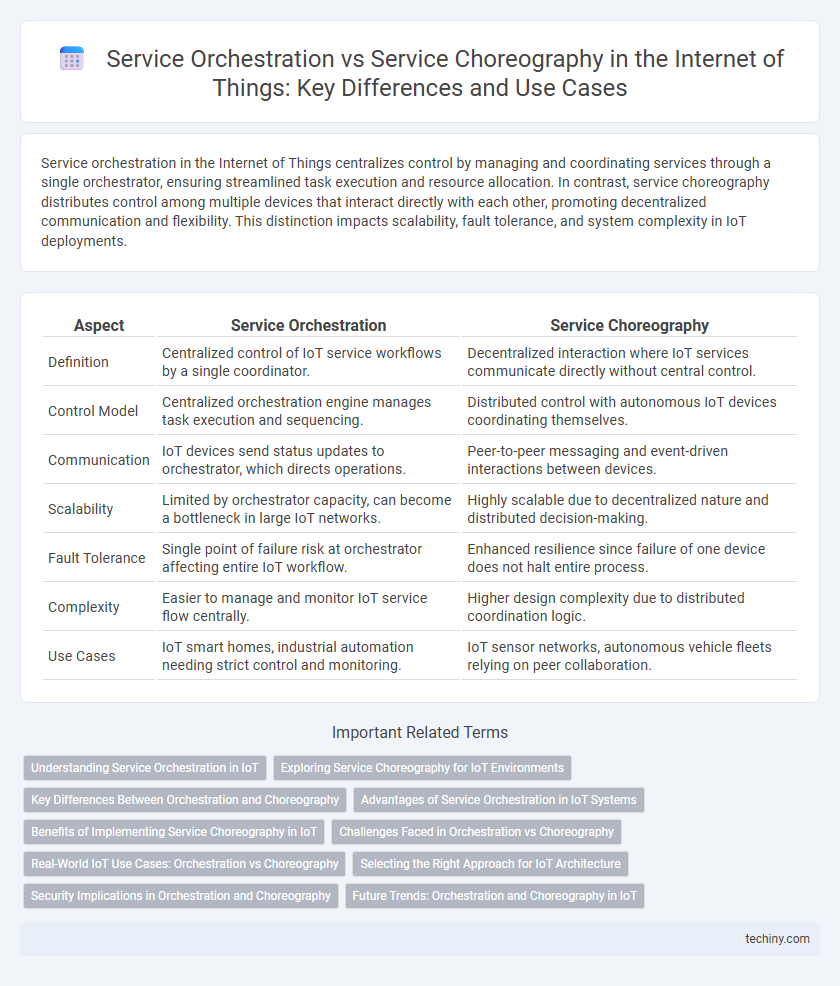Service orchestration in the Internet of Things centralizes control by managing and coordinating services through a single orchestrator, ensuring streamlined task execution and resource allocation. In contrast, service choreography distributes control among multiple devices that interact directly with each other, promoting decentralized communication and flexibility. This distinction impacts scalability, fault tolerance, and system complexity in IoT deployments.
Table of Comparison
| Aspect | Service Orchestration | Service Choreography |
|---|---|---|
| Definition | Centralized control of IoT service workflows by a single coordinator. | Decentralized interaction where IoT services communicate directly without central control. |
| Control Model | Centralized orchestration engine manages task execution and sequencing. | Distributed control with autonomous IoT devices coordinating themselves. |
| Communication | IoT devices send status updates to orchestrator, which directs operations. | Peer-to-peer messaging and event-driven interactions between devices. |
| Scalability | Limited by orchestrator capacity, can become a bottleneck in large IoT networks. | Highly scalable due to decentralized nature and distributed decision-making. |
| Fault Tolerance | Single point of failure risk at orchestrator affecting entire IoT workflow. | Enhanced resilience since failure of one device does not halt entire process. |
| Complexity | Easier to manage and monitor IoT service flow centrally. | Higher design complexity due to distributed coordination logic. |
| Use Cases | IoT smart homes, industrial automation needing strict control and monitoring. | IoT sensor networks, autonomous vehicle fleets relying on peer collaboration. |
Understanding Service Orchestration in IoT
Service orchestration in the Internet of Things (IoT) involves centralized coordination of multiple service components to automate complex workflows and ensure seamless interaction among diverse devices. This approach uses a central controller to manage service sequences, data flow, and error handling, optimizing system efficiency and reliability. Understanding service orchestration enables IoT developers to design scalable, manageable, and flexible applications that integrate heterogeneous devices and protocols effectively.
Exploring Service Choreography for IoT Environments
Service choreography in IoT environments enables decentralized coordination where multiple devices interact autonomously without a central controller, enhancing scalability and fault tolerance. This approach distributes control logic among IoT nodes, allowing dynamic and flexible service interactions tailored to real-time data and context changes. Compared to service orchestration, choreography better supports heterogeneous IoT architectures by fostering seamless interoperability and reducing latency in complex, large-scale deployments.
Key Differences Between Orchestration and Choreography
Service orchestration in the Internet of Things involves a central controller managing and coordinating all service interactions, enabling seamless integration and control across devices. Service choreography allows IoT devices to interact directly with each other based on predefined rules, promoting decentralized communication and autonomy. Key differences include orchestration's centralized control versus choreography's distributed interaction, with orchestration providing easier management and choreography offering greater scalability and flexibility.
Advantages of Service Orchestration in IoT Systems
Service orchestration in IoT systems enables centralized control and coordination of multiple devices and services, ensuring seamless integration and efficient workflow management. This centralized approach simplifies complex interactions, enhances scalability, and improves fault tolerance by allowing a single point of monitoring and error handling. Consequently, service orchestration supports dynamic adaptability in IoT ecosystems, optimizing resource allocation and reducing latency for real-time applications.
Benefits of Implementing Service Choreography in IoT
Service choreography in IoT enables decentralized coordination of devices, enhancing system scalability and fault tolerance by allowing autonomous interactions among multiple entities. This approach reduces bottlenecks and single points of failure compared to centralized service orchestration, improving overall network resilience. Implementing service choreography facilitates dynamic adaptability in IoT environments, optimizing resource utilization and real-time responsiveness across distributed devices.
Challenges Faced in Orchestration vs Choreography
Service orchestration in the Internet of Things faces challenges such as centralized control points leading to scalability bottlenecks and vulnerability to single points of failure, while ensuring synchronized execution across heterogeneous devices remains complex. Service choreography, however, struggles with achieving consistent global state and coordination without centralized oversight, resulting in increased complexity in fault management and debugging. Both approaches demand advanced mechanisms for security, interoperability, and dynamic adaptation to the rapidly changing IoT environments.
Real-World IoT Use Cases: Orchestration vs Choreography
Service orchestration in IoT centralizes control by coordinating multiple services from a single point, ideal for smart cities where real-time traffic management requires synchronized sensor data and actuator responses. In contrast, service choreography enables decentralized IoT devices to interact autonomously, suited for industrial automation scenarios where machines communicate directly for fault detection and process optimization. Real-world IoT use cases demonstrate orchestration's effectiveness in scenarios demanding centralized oversight, while choreography excels with distributed, event-driven device interactions.
Selecting the Right Approach for IoT Architecture
Service orchestration centralizes control by managing IoT device interactions through a single coordinator, enhancing reliability and simplifying workflow management. Service choreography distributes control across devices, enabling decentralized communication that increases scalability and fault tolerance in dynamic IoT environments. Selecting the right approach depends on factors like system complexity, latency requirements, and the need for centralized monitoring versus autonomous operation.
Security Implications in Orchestration and Choreography
Service orchestration centralizes control in Internet of Things (IoT) networks, creating a single point of vulnerability that can be targeted by cyberattacks, increasing the risk of data breaches and service disruption. Service choreography distributes control among multiple devices, enhancing resilience by minimizing centralized attack vectors but complicating security monitoring and enforcement. Effective IoT security strategies must balance orchestration's centralized oversight with choreography's decentralized protection to safeguard data integrity and confidentiality across connected devices.
Future Trends: Orchestration and Choreography in IoT
Future trends in IoT emphasize the integration of service orchestration and choreography to enhance system scalability and responsiveness. Orchestration centralizes control, enabling seamless management of complex service workflows across diverse IoT devices, while choreography promotes decentralized interactions, improving adaptability and fault tolerance. Advances in AI and edge computing are driving more intelligent, context-aware orchestration and choreography frameworks, supporting dynamic, real-time IoT ecosystems.
service orchestration vs service choreography Infographic

 techiny.com
techiny.com